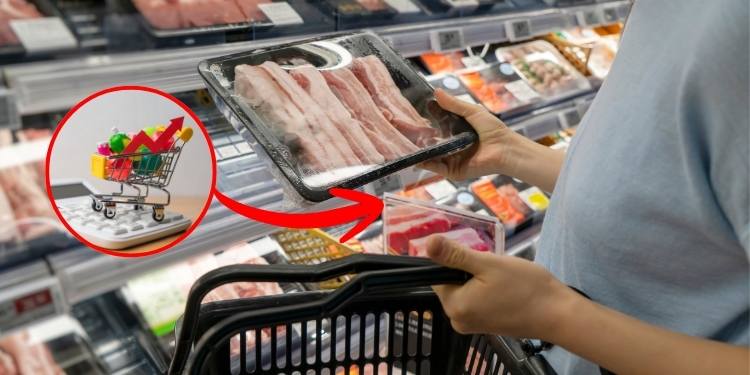It’s no secret that prices for items we use everyday have been climbing exponentially. If you’re a prepper, homesteader, or someone who simply wants to be more self-reliant, this surge in costs is a big hit to your preparedness plans.
The rising prices of key items like canned food, fuel, and medical supplies can make it feel overwhelming to build a stockpile or maintain a homestead. Yet, instead of letting the rise in prices slow you down, there are alternative approaches that can help you stay ahead of the game.
Let’s look at some things you can do to keep your preparedness on track without breaking the bank.
Canned Food Prices Skyrocketed
The price of canned food has gone through the roof, and it’s tough to justify buying cases when you’re trying to stock up and bills must still be paid.
Instead of relying on store-bought canned goods, I shifted my focus to canning my own food.
Not only does this save money, but I also have control over what goes into my food, avoiding preservatives and unnecessary additives.
If you haven’t already started canning, now is the perfect time to learn. It’s a simple process that can extend the shelf life of fruits, vegetables, and even meat for months or years. Whether you have a garden or buy in bulk when items go on sale, canning ensures that you have a reliable, affordable food supply.
PRO TIP
 Start small with water bath canning for high-acid foods like tomatoes and jams, then work your way up to pressure canning for meats and low-acid vegetables.
Start small with water bath canning for high-acid foods like tomatoes and jams, then work your way up to pressure canning for meats and low-acid vegetables.
Canned food is useful both from an economic perspective and because of its long shelf life. Recently, I’ve dedicated much of my energy to learning the tricks of canning.
My teacher was Eddie Swartzentruber, the author of The Amish Ways Book. This is a very valuable resource, which I went through in just a few days.
After that, I followed his steps exactly and managed to can food just as efficiently as one of the longest-standing off-grid communities in the U.S.
Here’s a list of foods I’ve found the Amish consistently can:
- Green beans and other garden vegetables
- Tomatoes (sauce, juice, stewed, or whole)
- Pickles and relishes
- Meat (chicken, beef, pork, venison)
- Fruits (peaches, applesauce, pears, cherries)
So, the most basic foods—those that provide quality calories and essential vitamins—can be preserved with ease. From here, you can learn exactly how.
Fuel Costs Are Soaring
Fuel prices have spiked, making it harder to stock up on propane, gas, or other fuels for long-term use. As a prepper, I knew I needed alternative energy sources to keep my home running in case of an emergency. One of the best decisions I made was investing in a small DIY power plant.
These devices have come down in price in recent years, and they’re a great way to keep essential electronics like radios, flashlights, and even small appliances powered when fuel is scarce.
I also made a long-term investment in a wood stove. Not only does it keep my home warm in the winter, but I can also use it to cook food and boil water.
Wood is a renewable resource, especially if you live in a rural area with access to a forest, and it provides a reliable backup in case grid power or fuel sources become unavailable.
PRO TIP
The best reference point when it comes to making fire by burning wood is the knowledge of outdoor survival experts.
From Nicole Apelian, I learned that there are several types of fire everyone should know how to build:
- The Swedish fire
- The Dakota fire hole
- The self-feeding fire
Each of these relies on principles that make them suitable only for certain circumstances.
However, many of those same principles can also be applied to maximize the efficiency of the wood you use to heat your home.
From The Wilderness Long-Term Survival Guide, you can learn everything about how to build each of the fires mentioned above, discover many other options, and understand the principles you can start applying today
Medical Supplies Are Getting Expensive
Medical supplies have seen significant price hikes recently, especially items like over-the-counter medications, bandages, and first aid kits. I built a stockpile made up of the essential antibiotics presented here, and then I turned to alternative options.
Instead of constantly buying expensive products, I turned to more natural and DIY solutions for the ailments that I and other family members deal with. I discovered that there’s a book with herbal protocols for the very problems I was looking to solve, namely:
Growing herbs like echinacea, chamomile, and calendula in my garden, using this affordable kit, has been a game changer. These plants have medicinal properties that can be used to treat everything from colds and cuts to anxiety and digestive issues.
I also started making my own herbal tinctures, salves, and teas. Not only are they more affordable than store-bought medicines, but they’re also sustainable since I can grow and harvest them myself.
For example, a simple tincture made from echinacea can boost your immune system during cold and flu season. Learning to rely on herbal remedies not only reduces your dependence on commercial products but also empowers you to take control of your health.
Grocery Bills Are Rising
Food prices don’t show any sign of slowing down or getting cheaper. So, instead of relying on grocery stores, I expanded my garden and started growing more of my own food.
By planting staples like potatoes, beans, and greens, I’ve been able to cut down significantly on my grocery bill and ensure that I have a fresh, healthy food source right in my backyard.
If you don’t have much space for a traditional garden, consider vertical gardening or container gardening. You’d be amazed at how much food you can grow in small spaces. And don’t overlook the value of heirloom seeds.
They’re not only more resilient, but you can save the seeds from year to year, reducing the need to keep buying new ones.
Egg Prices Are Up
 Eggs have become more expensive, and store-bought ones aren’t nearly as fresh as what you can get from your own backyard. I decided to take the leap and get a few chickens.
Eggs have become more expensive, and store-bought ones aren’t nearly as fresh as what you can get from your own backyard. I decided to take the leap and get a few chickens.
Raising chickens has provided me with a steady supply of eggs. During WWII, the British faced a major energy crisis caused by Nazi attacks.
In 1941, specifically, all electrical food preservation systems became nonfunctional. Ordinary people had to improvise and discovered a brilliant method that allowed them to keep eggs edible for up to 10 years.
In The Lost SuperFoods, you can find information on how to preserve eggs long-term, as well as over 125 long-lasting recipes based on affordable ingredients.
Besides eggs, raising chickens also gives me natural fertilizer for my garden (more on that in a minute).
Chickens are relatively easy to care for, and even if you’re in a suburban area, many cities allow for a small backyard flock.
In addition to eggs, chickens can help with pest control, eating bugs and weeds that could damage your garden.
Plus, if things ever get tough, they can be a source of meat as well. Just make sure to check your local regulations before starting your own backyard coop.
Store-Bought Fertilizer Costs Are Rising
With the cost of fertilizers increasing, I realized that I didn’t need to rely on store-bought solutions to keep my garden productive. Instead, I turned to composting and other homemade fertilizers.
By composting kitchen scraps, yard waste, and manure from my chickens, I’ve been able to create nutrient-rich soil for my garden without spending a dime.
Another great option is to make your own liquid fertilizers from items you already have around the house.
For instance, banana peels soaked in water make an excellent potassium boost for plants, and eggshells can be ground up to add calcium to the soil. These DIY solutions not only save money but also reduce waste and make your garden more sustainable.
Other Prices Will Keep Climbing
While inflation and supply chain issues are making everything more expensive, one thing is certain: prices will likely continue to rise. That’s why I’ve started stocking up now on items that I know will only get more expensive.
Canned goods, long-term food storage, medical supplies, and even certain tools are all items I’m adding to my stockpile before costs climb further.
But I’m not just throwing money at the problem—I’m being smart about it. I watch for sales, buy in bulk when I can, and focus on the essentials.
I also make a point to repurpose items around the house to save even more money. For example, old clothing can be cut up for rags, and glass jars can be reused for storage or even for canning.
Final Thoughts
While prices for preppers and homesteaders are rising, there are plenty of ways to stay ahead of the game.
By focusing on DIY solutions, renewable resources, and long-term investments like solar power or a garden, you can continue to build your self-sufficient lifestyle without breaking the bank.
Remember, the key is to stay flexible, creative, and always keep learning new skills. The more self-reliant you become, the less those rising prices will affect you.
Concerned with self-sufficiency when it comes to food and energy, I decided to tackle the water issue the same way. I discovered the U.S. Army plans for The Water Freedom System and put them into practice myself. For bug-out situations, I turned to this 5-minutes-to-pack water generator. Total game changers—both of them.
You may also like:
Cheap and Easy DIY Fire Starters That Every Prepper Should Know
This Nuclear-Proof Root Cellar Will Keep Your Food Safe For Years (Video)
























Prices are soaring. Wow, what an insightful revelation.
Next we will learn that water is wet.
I’m trying to raise my own garden but not very good at it. I hunt every season want to learn how to can meat, I got chickens need to butcher the old hens and can that meat. but don’t remember how I was about 10 when I last helped my parents and that was 70 + yrs ago
Crystal Hayward
Here is some info on canning that will help you remember what y’all did as a kid. It has not changed much since then to now.
Canning-National center for home Preservations. Go to this Web site…
Hope it will help you get back to canning…
Been using this hoss on the farm love it….. https://www.vevor.com/gas-chainsaws-c_13329/62cc-gas-chainsaw-3-8-hp-gas-powered-20-inch-chainsaw-for-wood-cutting-p_010347057565?lang=en¤cy=usd&utm_source=inhouse&utm_medium=affiliate&utm_campaign=57660419&shortkey=20250914npr2
no shit! things have been going up since 9/11, Democrats and Covid. It’s no big economics project.
The article isn’t about winning an economics debate, it’s about what we can do right now to stretch our resources and prepare smarter. If you feel there are better angles we should cover, throw them out here. We’re always looking for input from folks who live this life every day.
I get your sarcasm, but the point of the article wasn’t to break the news that prices are going up. Everyone already sees that at the checkout line. The purpose was to offer practical ways to deal with it. If you’ve got ideas for topics you’d like us to cover, I’d genuinely like to hear them.
Water is wet???
Wow, who would have thought?
JoAnn
The holidays are coming (hopefully, anyway…) Most big box stores will run sales on canned goods in preparation for holiday entertaining/dining. In past years I have bought cases of corn and green beans at 50 cents a can. Not a bad deal on factory fresh canned goods that will last longer than salvage/surplus of questionable quality and manufacture date.
Howdy from high in the desert swamp,
Crystal if you want to learn to pressure can, there are many YouTube channels. It really isn’t all that difficult. Watch several different people and just go for it. If people could do this back in the woods or out on the prairie with firewood and a stove, I can do it in my air conditioning kitchen. The stove really does almost all the work. And while you’re at it, have fun doing it.
Remember the Alamo
Remember 9/11
Remember North Carolina
Remember to have your soul prepared
Remember Charlie Kirk
Holiday sales are one of the best times to stock up without breaking the bank. Buying factory-fresh canned goods at those prices is smart, especially since you know exactly what you’re getting. Thanks for pointing this out. A lot of people overlook seasonal sales as a prepping strategy.
Just me – read red ant, REGULARLY, same with chap Dan. You post, not helpful. TRUE that we know prices are UP, but grass is green and we dont need any comments that we know that. It was mentioned to drive the point home, we have even MORE need for those skills , more than SHTF.
Crystal, they told you right. In fact, I have put up over 30 Qts of pickles and over 20 pints of Preserves, THEN I bought the new ball blue book on HOW to do it, in case I have a question in the future, like canning meat. update, ran into local man, told me raw meat, jar it, 90 minutes, water bath or pressure – pressure I think. said the pulled pork was THE BEST, and that it keeps 20 years.
Ghorn, good tip ! Thanks, making room for many cases before oct ends.
Chap Dan, aces !
just me, Constructive criticism is an Art, takes lots of effort and I know you can do that well, better than I did.
Food storage help from Kre
here comes FROST !
At the last minute, pick every green tomato you can. wrap them in thick or double layer news print. place them in shallow boxes, bread trays – with air holes are BEST !
place in cool dry spot, dont even peek for a month. After that, open them 1 at a time weekly for inspection. You will be eating fresh tomato’s well into January. they will not all ripen at once. Many people will save over a bushel of tomato’s this way, besides, they taste better than the cardboard ones you get at mega mart in December.
Thanks for taking the time to share so many practical tips. The part about pressure canning pulled pork lasting decades is especially interesting. And the green tomato trick is a lifesaver for folks who hate to see their garden go to waste before frost.
Do I need to cover the shallow tray or box of green tomatoes?
As always, a good article, minus the criticism… As for the canning info, never bad info… personally I have yet to attempt canning, I do plan to sometime soon, but for right now, I visit 3-4 local nearby town’s Farmers Markets, and its there that I get my canned stuff… I get to talk to the person who does the canning, get to know them, and the care they put into their canning ventures… So far I had real good luck amassing several excellent jars of green beans, okra, tomatoes, squash, etc.. lots of jelly’s and jams, my favorite being Pear preserves…to go with my hot buttered biscuits … a good variety of salsa’s as well, being Texan, have to have a good supply of salsa and pico… and can’t forget pickles, jalapeños, and such… I also make it a point to stop at road side stands to check out their stock… Farmers Markets are well stocked in advice for canning and tons of other stuff pertaining to this subject… a wealth of info all lined up and willing to discuss it for as long as your willing to listen… sometimes they might even let it slip out that they are preppers as well… Always good to know for later references… lots of crafts to behold…. you’d be surprised as to what you can find at a Farmers Market… Live Long and Prosper, as always, Gig Em…